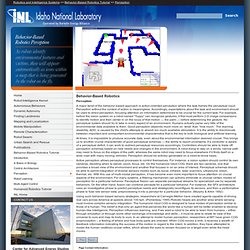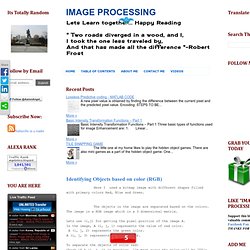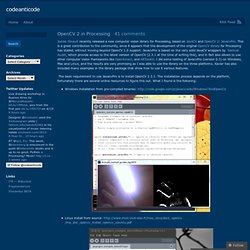

RoboCup Software - GT RoboJackets. From GT RoboJackets RoboCup Software encompasses all parts of the system that run on a host machine (not the robots).

The entire software system is composed both of the components we play soccer and compete with as well as a sort of SDK that allows new components to be written quickly for idea and system testing. We currently host our software project on github, so check it out: soccer Everything after vision and before radio happens here. simulator. Behavior-based Robotics Perception. Perception A major tenet of the behavior-based approach is action-oriented perception where the task frames the perceptual input.

Perception without the context of action is meaningless. Accordingly, expectations about the task and environment should be used to direct perception, focusing attention on information determined to be crucial for the current task. Guidelines for Best Practices in Image Processing. Identify colors in an RGB image. Identifying Objects based on color (RGB) Here I used a bitmap image with different shapes filled with primary colors Red, Blue and Green.

The objects in the image are separated based on the colors. The image is a RGB image which is a 3 dimensional matrix. Lets use (i,j) for getting the pixel position of the image A. Image processing - What is the most accurate way of determining an object's color. Announcing OpenCV for Processing. I’m proud to announce the release of OpenCV for Processing, a computer vision library for Processing based on OpenCV.

You can download it here. The goal of the library is to make it incredibly easy to get started with computer vision, to make it easy to experiment with the most common computer vision tools, and to make the full power of OpenCV’s API available to more advanced users. Announcing OpenCV for Processing. OpenCV 2 in Processing. Xavier Hinault recently released a new computer vision library for Processing, based on JavaCV and OpenCV 2: JavacvPro.

This is a great contribution to the community, since it appears that the development of the original OpenCV library for Processing has stalled, without moving beyond OpenCV 1.0 support. JavacvPro is based on the very solid JavaCV wrappers by Samuel Audet, which provide access to the latest version of OpenCV (2.3.1 at the time of writing this), and in fact also allows to use other computer vision frameworks like OpenKinect, and ARToolKit. I did some testing of JavacvPro (version 0.3) on Windows, Mac and Linux, and the results are very promising as I was able to use the library on the three platforms.
Xavier has also included many examples in the library package that show how to use it various features. Docs.opencv.org/opencv_tutorials.pdf. Www.cc.gatech.edu/~daleshin/OpenCV_Tutorial.pdf. ARToolKit Marker Generator Online released! « flash.tarotaro.org.blog. Object Detection from Webcam. OpenProcessing - Share your sketches! Detect() \ language (API) Detect object(s) in the current image depending on the current cascade description.

This method finds rectangular regions in the current image that are likely to contain objects the cascade has been trained to recognize. It returns found regions as a sequence of rectangles. The default parameters (scale=1.1, min_neighbors=3, flags=0) are tuned for accurate (but slow) object detection. For a faster operation on real-time images, the more preferable settings are: scale=1.2, min_neighbors=2, flags=HAAR_DO_CANNY_PRUNING, min_size= Mode of operation flags: for each scale factor used the function will downscale the image rather than "zoom" the feature coordinates in the classifier cascade. If it is set, the function uses Canny edge detector to reject some image regions that contain too few or too much edges and thus can not contain the searched object.
OPENCV \ library. OpenCV is an open source computer vision library originally developed by Intel.

It is free for commercial and research use under a BSD license. The library is cross-platform, and runs on Mac OS X, Windows and Linux. It focuses mainly towards real-time image processing, as such, if it finds Intel's Integrated Performance Primitives on the system, it will use these commercial optimized routines to accelerate itself. This implementation is not a complete port of OpenCV. Currently, this library supports : real-time capture video file import basic image treatment (brightness, contrast, threshold, …) object detection (face, body, …) blob detection Future versions will include more advanced functions such as motion analysis, object and color tracking, multiple OpenCV object instances …
Thomasdiewald.com. Diewald_CV_kit. Diewald_CV_kit A library by Thomas Diewald for the Processing programming environment.

Last update, 13/12/2012. -------------------------------------------------------------------------------- this library contains tools that are used in the field of computer vision. its not a wrapper of openCV or some other libraries , so maybe you are missing some features ( ... which may be implemented in the future). its designed to be very fast to use it for realtime applications (webcam-tracking, kinect-tracking, ...). also, it works very well in combination with the kinect-library (dlibs.freenect - )... which i basically built it for ... to track blobs, generate contours from 3d-data, and else. it should work in combination with other libraries too, since the blobdetection is very flexible and works with any given data-arrays. the examples, that come with the library, demonstrates: kinect 3D/2D tracking a simple marker tracking image-blob tracking Download Installation.
Mesh.brown.edu/engn1610/szeliski/03-imageprocessing.pdf. Computer Vision Resources. Diuf.unifr.ch/main/diva/sites/diuf.unifr.ch.main.diva/files/joomla_nao_bachelor_report_final.pdf. OpenCV.